The Pre-Collision Assist of Ford, as its name says, helps prevent possible accidents by warning the driver of possible collisions with other vehicles, pedestrians, or obstructions on the road. This is pretty handy in poor lighting conditions or poor road visibility. It can lessen the impact of a frontal collision and even prevent one in most circumstances.
Pre-collision assist not available message highlights
- Common reasons:radar sensor blocked, camera blocked, wiring issues, software problems
- How to fix:clean the radar area, clean the camera, check the connections, read the codes
- Possible consequences:several radar-dependent functions won't work
- Priority level:Low
- Can you drive?Yes
- DIY repair:Possible
- Repair price range:$0-$1,500

Most Common Reasons and Fixes for the "Pre-Collision Assist Not Available" Warning in Ford Vehicles
The "Pre-Collision Assist Not Available" alert in Ford vehicles may be triggered by a lot of things. Based on the advisory of the American automaker, feedback from owners, forums, reports, and advice from mechanics, the following factors are its most common causes:
1. Obscured Camera and Radar Sensors
The most common causes of the "Pre-Collision Assist Not Available" warning message on the dashboard of Ford vehicles are obstructions in the field of view of the camera located on the side of the rearview mirror facing the windshield and/or the radar sensor located in the front grille.
Normally, these are due to dirt, heavy rain, snow, ice, or fog obscuring their operations. Oftentimes, these may be gone as soon as you're back within ideal environmental conditions or temperature, but if they don't, there are some methods you can employ to eliminate them.
For dirt, a simple swipe on the windshield area with an appropriate cleaning solution and microfiber cloth should do the trick. If you have access to it, a water jet washer can help flush away any dirt that has been baked on it by prolonged exposure to sunlight.
Heavy rain or snow may sometimes require the use of window wipers but in some cases, it could still be blocked by ice buildup around the lenses of both sensors. To remove this, pour lukewarm water on these areas and then carefully scrape away the frost with a soft brush or cloth until they are clean.
Finally, the fog that is blocking your view can be taken care of with an anti-fog spray specifically designed for car windows or an equally effective household recipe of rubbing a tiny bit of toothpaste and water onto the windshield. With these steps, you should find that your Pre-Collision Assist system is back up and running perfectly in no time.
Pay attention to any warning messages on the dashboard while driving to avoid potential hazards. If they don't seem to be going away even after following these instructions, it may indicate an issue with the camera or sensors themselves and further assistance will be necessary. Have them checked out by a professional as soon as possible to ensure the safe operation of your car's safety systems in all conditions.
In addition, maintain regular maintenance checks to make sure your Ford vehicle performs at its peak performance and reliability standards.
By staying proactive about keeping your car's sensors clear of obstructions and keeping up with regular maintenance, you can rest assured that your Ford vehicle is as safe and reliable as it should be.? Taking these simple steps will ensure that you stay one step ahead of any potential problems.
2. Malfunctioning Camera and Radar Sensors
If there are no obstructions in the field of operation of the camera and radar sensors, and yet, you are still getting the "Pre-Collision Assist Not Available" warning on the dash of your Ford, then you might consider checking the said components for possible faults.
To begin with, you will need the necessary tools to diagnose the malfunctioning camera and sensors. These would include diagnostic tools such as a power probe, digital multimeter, oscilloscope, scan tool, and other specialized testing equipment.
The first step is to test all of the wirings that run between the components and any other associated connections in order to guarantee that they're free of faults. If there are no loose or broken wires detected, then you can move on to testing the sensors themselves by using an oscilloscope.
This should allow you to identify whether they are producing accurate readings. If they are not producing accurate readings then this could be down to a fault with either one or both of them or their connection points.
In this case, the faulty component must be repaired or replaced. If the fault is found to be within the connection point then it should be checked for any signs of damage and any damaged parts must be changed. After completing this process, you will have to run another test on the camera and radar sensors to confirm that they are consistently functioning correctly.
3. Misaligned Radar
The radar sensor, located on the front grille of Ford vehicles, is an essential component in the Pre-Collision Assist system. It functions by sending out a signal that detects objects that may be in the way of the car and alerts drivers to potential hazards. Proper installation and alignment of this component are important for the correct functioning of the warning system.
The most common cause of misalignment is poor mounting or incorrect placement during installation. This could also stem from missing screws or bolts that may dislodge the component out of place. Strong vibrations produced by going through uneven roads, potholes, or major impact can be possible culprits, too.
To ensure the proper alignment of the radar sensor, see to it that has been properly mounted using all necessary hardware and that it does not wiggle or shift after mounting. Make sure that the sensor radar is also properly calibrated during the installation process to prevent more issues from popping up.
For better results, always consult your vehicle's manual while servicing the radar components or have the task done by a professional mechanic all the way.
4. ECU Errors
The Engine Control Unit (ECU) is a critical component in the operation of any vehicle, as it manages many functions like fuel injection, ignition timing, and other aspects of the engine as well as the overall performance of its electrical system.
In Ford vehicles, a malfunction in the ECU can also often result in the dashboard warning "Pre-Collision Assist Not Available" being displayed. This pre-collision system helps drivers to avoid dangerous collisions by giving them advance warning when an obstacle is detected near the front of their car.
When this system fails due to a problem with the ECU, it puts drivers at an increased risk for accidents.
In some cases where there is a fault within the ECU, reflashing may be able to solve it without having to replace the entire unit. Reflashing is a process of reinstalling the code onto the ECU, which has access to sophisticated diagnostic software. This restores all the settings in the ECU back to their original programming and can often solve any existing software issues.
While reflashing does not always fully restore functionality, it is usually successful when there is a problem that only affects software within the system and not the physical hardware components.
It is wise for drivers to have this process done if they receive a "Pre-Collision Assist Not Available" warning on their Ford vehicle so as to reduce their risk of getting into an accident. Performing regular maintenance and inspections can also help prevent these types of problems from arising in the first place.
If the quality of the car computer hardware has been compromised, you may have to replace the entire ECU or its affected modules to fix the problem.
5. Overheating Components
Diagnosing the engine bay's overheating components that can lead to the "Pre-Collision Assist Not Available" warning on Ford vehicles is relatively straightforward. Start by checking the wiring, connectors, and relays connected to the front grille radar sensor. Make sure they are securely attached and working properly. If any of them appear faulty or loose, replace or reconnect them as necessary. Additionally, inspect both the fuses and circuit breakers located near the radar sensor for any signs of damage. Replace any that are defective or blown out.
There could also be an issue with either a vacuum leak in the engine bay or a clogged air filter that is causing hot air from the car's exhaust system to enter into it. To confirm your suspicions, run a vacuum leak test to identify any leaks in the system. If one is present, seal it up using the appropriate materials. Similarly, if the air filter is clogged or dirty, replace it with a new one and reset the configuration of the sensor.
Conclusion
The "Pre-Collision Assist Not Available" in Ford may be due to a lot of things. The most common are obstructions in the radar sensors or objects obscuring the camera. Therefore, the best way of fixing or preventing the problem mostly involves keeping them clean at all times.
However, should the cause of the issue be due to malfunctioning components, the problematic parts should be replaced right away to ensure the proper operation of your car's driver assistance system.
About the authors
The CarAraC research team is composed of seasoned auto mechanics and automotive industry professionals, including individuals with advanced degrees and certifications in their field. Our team members boast prestigious credentials, reflecting their extensive knowledge and skills. These qualifications include: IMI: Institute of the Motor Industry, ASE-Certified Master Automobile Technicians; Coventry University, Graduate of MA in Automotive Journalism; Politecnico di Torino, Italy, MS Automotive Engineering; Ss. Cyril and Methodius University in Skopje, Mechanical University in Skopje; TOC Automotive College; DHA Suffa University, Department of Mechanical Engineering






Add comment